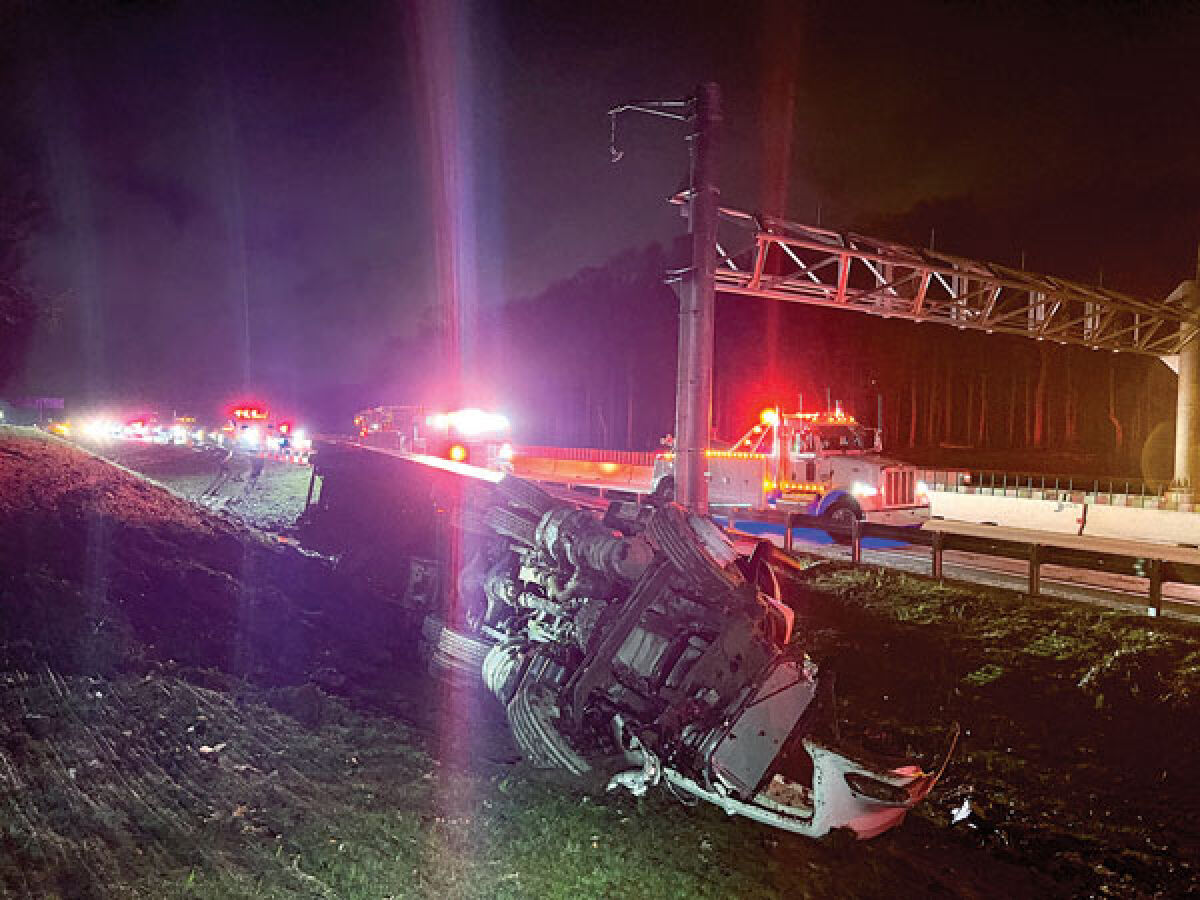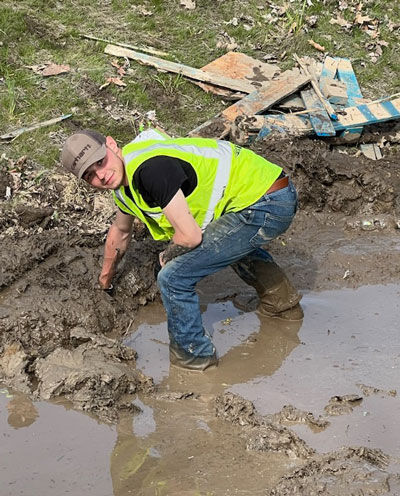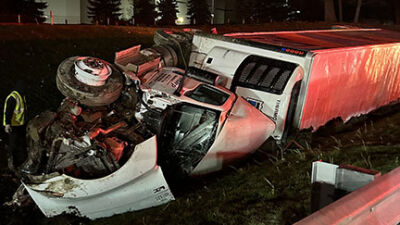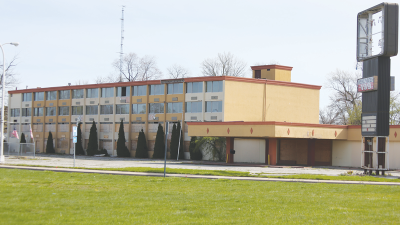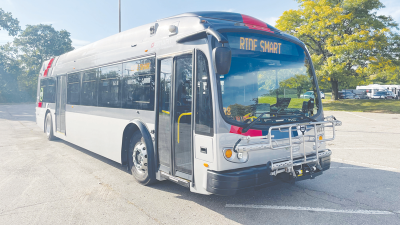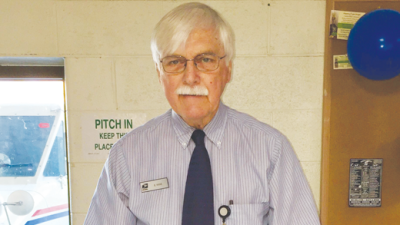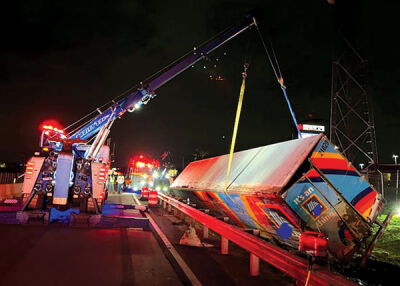
Hadley’s Towing utilizes a rotator truck, along with some heavy-duty wreckers, to turn the overturned semitruck upright.
Photo provided by Hadley’s Towing
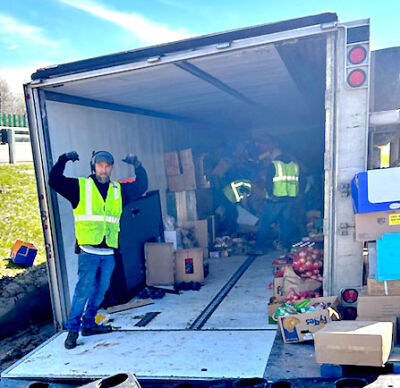
Aaron Essley, a worker from Hadley’s towing, flexes his muscles as he finishes unloading the semi.
Photo provided by Hadley’s Towing
NOVI — Thirteen men, seven heavy-duty tow trucks and a street sweeper were required to clean up the scene following a semitruck crash on eastbound Interstate 96 near Beck Road and the Suburban Collection Showplace April 18.
At 1:25 a.m. April 18, a semitruck driver with a load of about 40,000 pounds of groceries veered off the highway. The truck landed on its side in the ditch on the opposite side of the guardrail. The driver was OK; however, the work was just beginning for workers at Hadley’s Towing in Novi.
Hadley’s employees would spend around 20 hours clearing the debris from the freeway, with work performed in three phases. The initial phase where the scene was secured took place from 1:30 to 6:30 a.m. During this time, the tow truck company pumped the remaining fuel from the tractor and pulled the truck to a better location to be able to turn it upright.
“We dispatched a few trucks, went out there, started to tackle the scene. There was some hazmat situations. I guess there was a fuel tank that was ruptured on the truck and another one that was full, so we had to pump off the fuel from the truck before we could move it at all,” said Kipp LeMarbe, vice president of Hadley’s Towing in Novi. “So we did that and then we pulled the truck almost down to the end of the guardrail.”
A refrigerated truck has two to three gas tanks — one for the refrigerated unit on the trailer and one or two for the tractor. LeMarbe’s crew pumped an estimated 40 to 50 gallons of fuel out of the truck, but there was still a spill from the ruptured tank of around 35 gallons of diesel, according to Diane Cross, of the Michigan Department of Transportation.
Then in what LeMarbe said was a first for him, MDOT chose to pause the recovery and cleanup process and reopen the freeway until the early evening to allow both of the daily traffic rush hours, morning and evening, to pass.
“This is the first time ever that MDOT has said, ‘Let’s leave it and then come back.’ Like, that never happens. Usually we are out there from the time it happens to the time we get it out of there. So this was a first for us,” LeMarbe said.
“We always look at multiple factors in any freeway crash. Obviously, the safety of the cleanup area for first responders and the general public, which frequently requires lane closures, if not a freeway closure. If there is a hazmat spill, depending on what it is, sometimes it has to be taken care of immediately; i.e. going into a nearby water source,” Cross said. “In this case and many others, the cleanup can be done at a later date under a permit. The hazmat company will apply for a permit to work on our roadway right of way, and we determine when it’s the safest time frame to do it.”
While the freeway was still open, Hadley’s workers cut a section out of the fence dividing the freeway and the parking lot of Suburban Collection Showplace.
“So, we could continue to unload the semi and work the scene without causing any disruption in the flow of traffic,” LeMarbe said. This was the second phase.
They then manually emptied the truck, working from 9 a.m. to 5 p.m. hauling groceries approximately 60 yards from the site of the crash up the embankment, through the fence, into the Suburban Collection Showplace parking lot and then into waiting box trucks to be disposed of at a nearby dump. In order to safely unload the truck, a skid-steer loader and a telehandler were used to help move stuff out of the truck and up the hill
“We continued unloading the semi because of the situation it was in. It was down in the mud, in the ditch, behind the guardrail, and it was full,” LeMarbe said. “So, you can’t roll them back over when they’re full of stuff like that — just because of the weight and things coming undone and what’s loose inside, it will break through the wall. So, we had to manually unload it by hand and that was done throughout the day.”
According to LeMarbe, the owner of the cargo and trailer said that anytime they have a situation like this where food that requires refrigeration is not able to be properly cooled and there’s a hazmat situation, that the goods are considered a “cross-contamination loss” and everything is to be disposed of.
Phase three began at 6:30 p.m. when MDOT once again shut down the freeway to allow the tow truck workers to remove the semi and the debris from the scene. To finish the job, Hadley’s brought in seven trucks including a rotator, some heavy-duty wreckers, some flatbeds, and the sweeper.
The flatbeds were used to haul away debris such as pieces of the trailer and other wreckage, and one of them had cleanup supplies for the hazmat situation and another brought in the sweeper. The heavy-duty wreckers and the rotator were used to flip the truck upright, and the sweeper was used to clean up the mud and debris off the roadway following the recovery of the semi.
The position of the truck made for quite a challenging recovery as a result of the guardrail and the culvert, LeMarbe said.
“Typically, if there is no guardrail, we can just flip it over, pull it back up to the road, but this one we had to make the decision whether to remove the guardrail or cut it and pull it out or drag it down past the guardrail and then flip it and bring it up over the culvert that was at the end,” LeMarbe said.
They ultimately decided on the latter and dragged the truck past the guardrail to flip it and then bring it over the culvert.
Another factor that complicated the recovery was the amount of water and mud in the area.
“With the warmer temperatures and the fresh construction there on that side and the water and the mud, it was a mess,” LeMarbe said.
“You got the guardrail and culvert as far as the recovery goes, and then as far as the unload goes, working in the mud, it was, it was pretty rough,” he said.
MDOT estimated the nighttime freeway closure might take up to eight hours; however, the project was completed in six hours. Cross said MDOT allows extra time in case there are any issues.
“These crash scene cleanups can have a lot of unexpected things happen,” Cross said.
LeMarbe attributed the speedy cleanup time to his experienced crew.
Hadley’s tows for about five different police agencies in the area, LeMarbe said. He said they are clearing accident scenes every day, but 9 times out of 10 they are just regular automobiles, which he said can still be challenging. He said last year they handled three semitruck wrecks.
“It’s hard to say (how many semi crashes they see on average); with the construction out there, it definitely amps it up a little bit. I mean, last year we had probably three semi wrecks with that construction in place,” LeMarbe said. “So not all that often. I’d say a few times a year, a couple times a year, depending.”
He said that the number of wrecks they see has increased every time the highway construction has begun for the last three years.
The hazmat recovery also happens in phases, according to LeMarbe. He said his company performed the first phase of the hazmat cleanup by pumping out the fuel before the truck was turned upright and putting down some oil absorbent.
“Usually, if that is kind of a clean deal and there is nothing spilled into the ditch, then there is no second portion,” he said. “Other times, if there is any kind of residual left over in the soil, then they come out and test the soil and they will dig and extract the soil that’s contaminated.”
He said that it can even take up to a week to acquire a permit to remove the contaminated soil, regrade it and replace it with topsoil and seed, which LeMarbe does not do.
“We just do some of the light-duty end of it. You know, to get things started,” he said.
Cross said that the diesel fuel spill of about 35 gallons from the ruptured tank would be cleaned up in the near future. She said the trucking company has hired a hazmat company that will request a permit to get back into that area, coordinated with the I-96 Flex Route project, to test and clean up the spill.
“It was a pretty big job to say the least,” LeMarbe said. “It was a long 20 hours, that’s for sure.”
 Publication select ▼
Publication select ▼